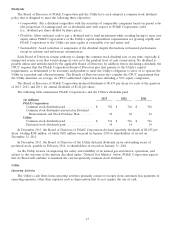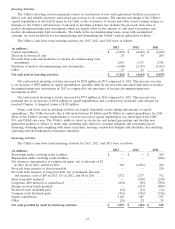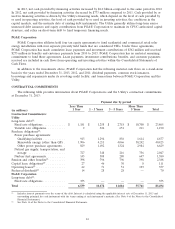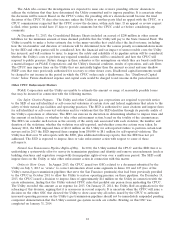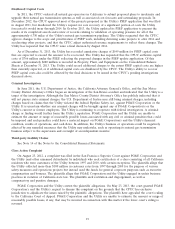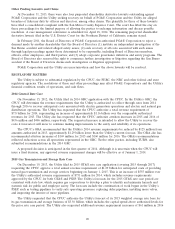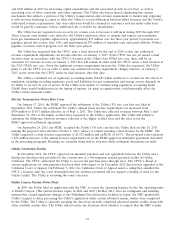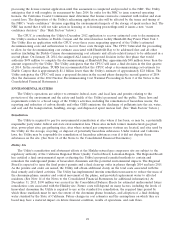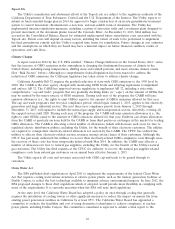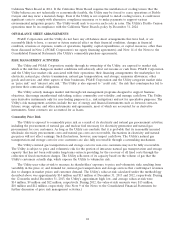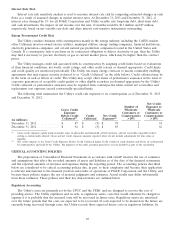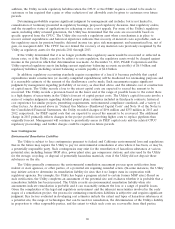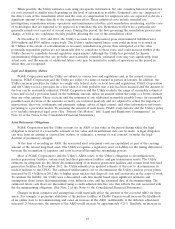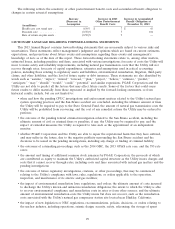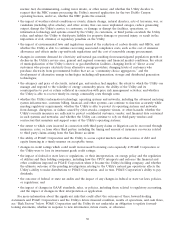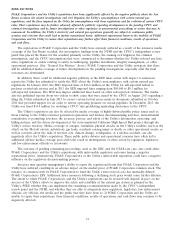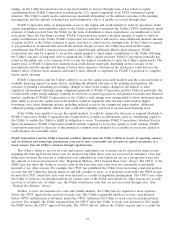PG&E 2013 Annual Report Download - page 29
Download and view the complete annual report
Please find page 29 of the 2013 PG&E annual report below. You can navigate through the pages in the report by either clicking on the pages listed below, or by using the keyword search tool below to find specific information within the annual report.Topock Site
The Utility’s remediation and abatement efforts at the Topock site are subject to the regulatory authority of the
California Department of Toxic Substances Control and the U.S. Department of the Interior. The Utility expects to
submit its final remedial design plan in 2014 for approval to begin construction of an in-situ groundwater treatment
system to convert hexavalent chromium into a non-toxic and non-soluble form of chromium. The Utility has
implemented interim remediation measures, including a system of extraction wells and a treatment plant designed to
prevent movement of the chromium plume toward the Colorado River. At December 31, 2013, $264 million was
accrued in the Consolidated Balance Sheets for estimated undiscounted future remediation costs associated with the
Topock site. Future costs will depend on many factors, including the extent of work to be performed to implement
the final groundwater remedy and the Utility’s required time frame for remediation. Future changes in cost estimates
and the assumptions on which they are based may have a material impact on future financial condition, results of
operations, and cash flows.
Climate Change
A report issued in 2012 by the U.S. EPA entitled, ‘‘Climate Change Indicators in the United States, 2012’’ states
that the increase of GHG emissions in the atmosphere is changing the fundamental measures of climate in the
United States, including rising temperatures, shifting snow and rainfall patterns, and more extreme climate events.
(See ‘‘Risk Factors’’ below.) Although no comprehensive federal legislation has been enacted to address the
reduction of GHG emissions, the California legislature has taken action to address climate change.
California Assembly Bill 32 requires the gradual reduction of state-wide GHG emissions to the 1990 level by
2020. The CARB is the state agency charged with monitoring GHG levels and adopting regulations to implement
and enforce AB 32. The CARB has approved various regulations to implement AB 32, including a state-wide,
comprehensive ‘‘cap and trade’’ program that sets gradually declining limits (or ‘‘caps’’) on the amount of GHGs that
may be emitted by the major sources of GHG emissions. During each year of the program, the CARB will issue
emission allowances (i.e., the rights to emit GHGs) equal to the amount of GHGs emissions allowed for that year.
The cap and trade program’s first two-year compliance period, which began January 1, 2013, applies to the electricity
generation and large industrial sectors. The next three-year compliance period, from January 1, 2015 through
December 31, 2017, will expand to include the natural gas supply and transportation sectors, effectively covering all
the capped sectors until 2020. During each year of the program, the CARB will issue emission allowances (i.e., the
rights to emit GHGs) equal to the amount of GHGs emissions allowed for that year. Emitters can obtain allowances
from the CARB at quarterly auctions held by the CARB or from third parties or exchanges in the market for trading
GHG allowances. The CARB is allocating a fixed number of allowances (which will decrease each year) for free to
regulated electric distribution utilities, including the Utility, for the benefit of their electricity customers. The utilities
are required to consign their electricity-related allowances for auction by the CARB. The CPUC has ordered the
utilities to allocate their electricity-related auction revenues among certain classes of their customers. Although the
CPUC has previously authorized the utilities to recover their electricity-related GHG compliance costs through rates,
the recovery of these costs has been temporarily deferred until May 2014. In addition, the CARB may allocate a
number of allowances for free to natural gas suppliers, including the Utility, for the benefit of the Utility’s natural
gas customers. The Utility has filed requests at the CPUC for authority to recover the natural gas supplier-related
compliance costs from natural gas customers on an annual basis effective January 1, 2015.
The Utility expects all costs and revenues associated with GHG cap-and-trade to be passed through to
customers.
Clean Water Act
The EPA published draft regulations in April 2011 to implement the requirements of the federal Clean Water
Act that requires cooling water intake structures at electric power plants, such as the nuclear generation facilities at
Diablo Canyon, to reflect the best technology available to minimize adverse environmental impacts. In June 2012, the
EPA proposed changes to these draft regulations which, if adopted, would provide more flexibility in complying with
some of the requirements. It is currently uncertain when the EPA will issue final regulations.
At the state level, the California Water Board has adopted a policy on once-through cooling that generally
requires the installation of cooling towers or other significant measures to reduce the impact on marine life from
existing power generation facilities in California by at least 85%. The California Water Board has appointed a
committee to evaluate the feasibility and cost of using alternative technologies to achieve compliance at nuclear
power plants, including Diablo Canyon. The committee’s consultant is expected to submit a final report to the
23


